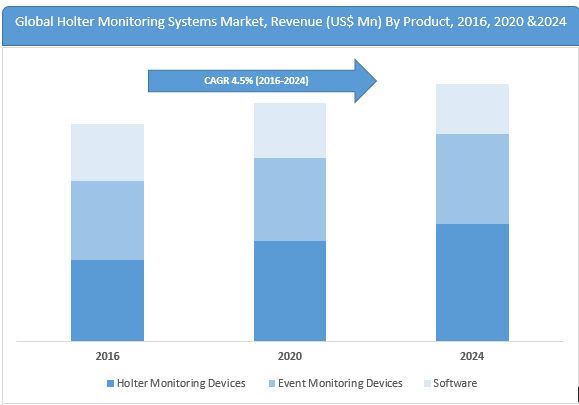- Blog
- Holter Monitoring Systems Market Innovation
Holter Monitoring Systems Market: Navigating Innovation in Cardiac Diagnostics
Published On : 6 Aug 2025
In an era where cardiovascular health is a central concern across global healthcare systems, the importance of continuous and accurate cardiac monitoring has never been more evident. Among the diagnostic tools gaining substantial ground is the Holter monitoring system, a discreet, portable device designed to record cardiac rhythms over extended periods. As healthcare moves steadily toward personalized, remote care, the global holter monitoring systems market is evolving in both scope and significance.

What Is a Holter Monitoring System?
A Holter monitor is a wearable electrocardiogram (ECG) device that tracks heart activity continuously- typically over 24 to 72 hours. Unlike a standard ECG performed in a clinical setting, Holter monitors are worn during daily activities, offering a more complete and realistic picture of a patient’s heart function. These systems are indispensable for identifying intermittent arrhythmias, silent ischemia, and other transient anomalies that may not appear during short-duration tests. They are widely used in the evaluation of symptoms such as:
- Palpitations or irregular heartbeats
- Unexplained fainting or dizziness
- Post-stroke cardiac monitoring
- Assessment of anti-arrhythmic therapy effectiveness
Major factors encouraging the need for holter monitoring systems:
- Rising Global Burden of Cardiovascular Disease
Cardiovascular diseases (CVDs) remain the leading cause of death worldwide, contributing to over 18 million deaths annually. As early detection becomes a strategic priority in preventive care, the demand for advanced diagnostic tools like Holter monitors continues to grow.
- Shift Toward Remote and Outpatient Care
As healthcare systems pivot toward decentralized models, ambulatory monitoring is gaining traction. Holter systems, being non-invasive and easy to use, are well-suited for home-based cardiac diagnostics and long-term monitoring.
- Technological Advancements in Wearable Diagnostics
The industry is benefitting from rapid innovation. Recent developments include wireless patch-based monitors, cloud-integrated platforms, and AI-driven analytics that can detect anomalies in real time. These innovations are not only improving diagnostic accuracy but also enhancing patient comfort and compliance.
- Increased Consumption of Alcohol and Nicotine
Busy and stressful lifestyles around the world have resulted in various health disorders. The consumption of alcohol and nicotine as a recreational activity has also surged, resulting in a greater risk of cardiovascular diseases. The global holter monitoring systems market has hence been witnessing heavy demand with the incidence of heart ailments on the rise.
How Emerging Technologies are Redefining Holter Monitoring?
Newer systems incorporate machine learning algorithms that pre-analyze ECG data, flagging patterns that may indicate arrhythmias, ischemia, or other cardiac events. These systems can automatically generate reports, significantly reducing the time clinicians spend on manual data review.
Wireless monitors are now able to transmit data securely to cloud platforms, where cardiologists can assess patient information in real time, often without requiring in-person visits. For example, devices like the Zio Patch by iRhythm offer up to 14 days of continuous monitoring in a discreet, adhesive form factor.
Such innovations are not only improving outcomes through earlier detection but are also aligning with the broader push toward value-based care, where efficiency and long-term cost savings are critical.
What Barriers Still Limit the Full Potential?
Despite strong growth prospects, the Holter monitoring market faces several systemic and operational hurdles.
- Data Privacy and Cybersecurity
With the increasing reliance on cloud-based and connected health technologies, data security remains a central concern. Unauthorized access to sensitive patient information could erode trust and invite regulatory scrutiny.
- Limited Penetration in Developing Markets
While high-income countries are quickly adopting advanced cardiac monitors, many regions in Latin America, Africa, and parts of Asia still lack access to modern diagnostic technologies. This gap is often attributed to cost constraints, insufficient healthcare infrastructure, and a lack of trained professionals.
- Reimbursement and Policy Gaps
Holter monitoring, particularly when conducted remotely, may not be adequately covered by insurance in several jurisdictions. This can be a deterrent for providers considering investment in newer technologies.
Recent Developments
- GE HealthCare introduced an AI-powered Holter platform with real-time ECG analysis.
- iRhythm Technologies expanded into the European market with regulatory approvals for extended-wear monitors.
- Qardio launched a new wireless system tailored for rural and home-based care.
Future Outlook
Looking ahead, Holter monitoring systems are expected to integrate more seamlessly with broader digital health ecosystems. We’re already seeing early signs of convergence between Holter monitors and consumer wearables, such as smartwatches capable of conducting single-lead ECGs.
By 2032, these devices could become part of predictive health models, using longitudinal data to forecast cardiac risk and proactively intervene before symptoms develop. The emphasis will shift from reactive diagnostics to preventive and personalized care.
Conclusion
The Holter Monitoring Systems Market represents a pivotal intersection of medical technology, data science, and clinical necessity. Its evolution reflects the broader transformation in healthcare delivery, one that favors remote, intelligent, and patient-centric solutions. However, realizing the full market potential will require collaborative efforts across the ecosystem. Industry players must continue to innovate, policymakers must support access and coverage, and healthcare providers must embrace new workflows that make use of continuous monitoring insights. For stakeholders positioned at this crossroad, the Holter monitoring segment offers not just commercial opportunity, but a chance to meaningfully reshape the future of cardiovascular care.
Industry Report

Request Report Sample
Your privacy is important to us; your data is secure
Contact Us
Latest Reports
-
Piezoresistive Pressure Sensor Market by Sensor Type (Absolute, Gauge, Differential, Sealed), Pressure Range (Low Pressure (<10 kPa), Medium Pressure (10 kPa – 1000 kPa), High Pressure (>1000 kPa)), End-Use Industry (Automotive & Transportation, Industrial Manufacturing, Healthcare, Aerospace & Defense, Electronics) and Regional Analysis for 2026-2033
-
Aquarium Accessories Market by Product Type (Filtration Items, Lights & Hoods, Temperature Control Systems, Others), End-User (Residential, Commercial), Distribution Channel (Online, Offline), and Regional Analysis for 2026-2033
-
Oxygen Therapy Market by Product Type (Compressed Oxygen, Concentrated Oxygen, Liquid Oxygen), Disease (Respiratory Disorder, Cardiovascular Disease, Sleep Apnea, Pneumonia), End-User (Hospitals, Home Healthcare, Clinics), and Regional Analysis for 2026-2033
-
Air Curtains Market by Product Type (Non‑Recirculating, Recirculating, Heated, Others), Airflow Capacity (Up to 500 m³/h, 500–1000 m³/h, 1000–1500 m³/h, Above 1500 m³/h), Application (Commercial, Industrial, Residential, Others), and Regional Analysis for 2026–2033
-
Personalized Stationery Market by Product type (Storage & Filling Products, Paper-Based Products, Drawing & Writing Instruments, Accessories, Bags, Others), Application (Educational Institutes, Corporate Offices, Personal Use, Hospitals, Others), and Regional Analysis for 2026–2033
